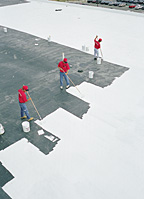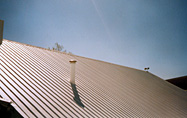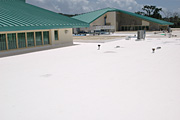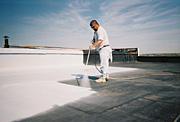White Coatings Under the Hot Light: Motives, Means, Materials and Opportunities

Many building owners view white coatings as a genuine advance in roofing technology, one that can extend the lives of roofing systems and lower energy bills [2,3]. A few consultants suggest that white coatings are "over-prescribed" and perhaps even have downsides, e.g., they can become soiled or cause too much glare to surrounding high rises as well as airline pilots and air traffic controllers [4,5]. Still others campaign for off-white roofs, garden roofs, shading, light-colored gravel and other green remedies against hot summers in the city and urban heat islands [6]. One thing is certain: Interest in white coatings is reaching new heights.
Basic chemistry teaches that chemical reactions occur more rapidly in heated materials, with reaction rates increasing exponentially with temperature. For many roofing materials, a rise of 20 or 30 degrees in peak roof temperature during the summer easily can shorten roof lifetimes by five or 10 years. If these temperature spikes can be reduced then the deterioration of roofing materials can be greatly slowed down. Furthermore, careful management of a roofing system through scheduled use of maintenance systems with reflective coatings could extend the lifecycle of a roof indefinitely.
Before looking at white coating formulations for cooling roofs, a little physics is needed to understand how roofs get so hot in the first place.

Solar Physics
Nobody knows better than roofing contractors how hot a rooftop can get in the summertime. Still, a little knowledge of the underlying physics can go a long way when it comes to white coatings.The solar spectrum can be divided into three bands, including ultraviolet (300-400 nm), visible (410-722 nm) and near infrared (724-2500 nm) accounting for approximately 5, 43 and 52 percent of the solar power, respectively [7].
More energetic photons hitting the roof are more likely to burst the molecular bonds of the roofing materials, ultimately leading to the deterioration of the roof. The most harmful of these are photons of ultraviolet radiation. Although there are fewer UV photons, they are potentially more damaging to roofing materials, so it is important for white coatings to reflect or block them.

Reflectance and Emissivity
Reflectance is measured according to strict standards. A perfect reflector would have a value of 100 percent for all wavelengths of light; when just one value of reflectance is given it usually represents an average value weighted according to intensity across the solar spectrum.With the growing recognition of reflectance as an important design parameter, reflectance values are being thoroughly measured across the spectrum and accurate values for specific materials and coatings are becoming readily available.
The beauty of a white coating is that the pigments such as zinc oxide (ZnO) or titanium dioxide (TiO2) scatter a large fraction of the incident photons back into the sky, especially in the visible and near infrared bands. Metal-oxide pigments used in white coatings scatter light by the same mechanism that light is scattered by the water droplets in a cloud, or fog; the scattering is due to the tiny particle size. Except for the small particle size, these materials would be transparent to light, because the metal atoms are oxidized, i.e., the valence electrons of the metals are held by the oxygen and do not interact with the incoming photons.
From the roof's perspective, the effect of scattering is the same as if the photons never arrived on the roof. This ability to scatter photons is characterized by the reflectance of a coating. Most white coatings have a very high reflectance across all visible wavelengths and also have a high reflectance for near infrared radiation (NIR). Typical reflectance values averaged over these wavelengths are in the neighborhood of 70 or 80 percent.
Besides reflectance, another important material property for roof surfaces is emissivity. Since not all of the incident photons are scattered, some heating of the roof is inevitable. And what goes in must come out! Emissivity is the ratio of radiation emitted by a surface and the theoretical radiation predicted by Planck's law. Blackbody emissivity is frequently referred to as a single number but, like reflectance, it varies with wavelength.
Know Your Coatings
Roofing contractors are being called on to develop expertise in white coatings. This requires some knowledge of basic physics but the biggest challenge is developing a familiarity with the many types of coatings, including their physical properties, their compatibilities (with other coatings and with various roofs), their methods of application and, finally, the recommended cleaning and maintenance schedules for the coatings.There are so many manufacturers of white and other types of roof coatings that contractors rightly may feel it is futile to learn the properties and performance of every type of coating. The best references for detailed specifications are the data sheets and technical bulletins from the individual manufacturers.
Nonetheless, there is a basic nomenclature (jargon) that a roofing contractor should know cold (pardon the pun) or he or she will likely be confused about white coatings. Accurate definitions of terms used in describing white coatings are essential, and these definitions may vary slightly from the usual definitions for the same words in other contexts. For example, the word "latex" is used with two completely different meanings within the definitions given here.
Some basic terms that a contractor should fully understand are white coating, organic compounds, silicones, polymers, elastomers, latex, acrylic and rubber. See sidebar for useful definitions of these terms.
The main components of most white coatings are the binder, pigment and water. Water serves as a liquid carrier, reducing viscosity to allow the pigment and binder to be spread on the roof as a thin coating. The majority of white coatings in use today are water-based coatings. For some white coatings, organic solvents are used as the liquid carrier. Also, some coatings made from multiple-part resins that are often blended on site; such coatings may have sufficiently low viscosity before curing to eliminate the need for a solvent.
Equipped with a sound understanding of chemical terminology, contractors should be able to navigate the manufacturers' literature describing white coatings. When in doubt, speak with a company representative or a knowledgeable roofing consultant, and with experience you too will gain a reputation as a technical expert on white coatings.

Properties of Coatings
Creating a waterproof barrier to atmospheric elements is the primary objective of any roof system. A high-quality roof coating will assist in this process by providing resistance to UV radiation and the effects of heavy or light rainfalls and standing and melting snow on roofs.The ability of these coatings to stand up to the elements depends largely on the application of the properly balanced ratio of acrylic solids to fillers in the coating, the thickness at time of application, and, of course, proper roof preparation and workmanship.
Roofers should be aware that specific guidelines have been established for testing and approval of liquid-applied acrylic roof coatings. Such information is often displayed on the labels of products that meet specific standards. Contractors should look for such markings when evaluating products to meet specific needs. Some markings indicate whether a coating meets specific standards or has the approval of certifying testing organizations.
Among the important standards is American Society for Testing and Materials (ASTM) D 6083. That standard measures the coating tested against specific physical performance and physical characteristics for viscosity, elongation, tensile strength, accelerated weathering after exposure to 1,000 hours of testing, permeance, water swelling, adhesion, tear strength, and low-temperature flexibility. Evidence that this comprehensive set of standards has been met is an indicator of an excellent product.
Know-how for Contractors
Contractors are in a unique position to develop expert knowledge about roof coating applications. White coatings are not for every building but countless buildings are excellent candidates for white coatings.Workmanship is a key variable that has a significant effect on the success of the white coating project, and nothing succeeds like success. Contractors who build reputations as knowledgeable and reliable installers of white coatings can expect to expand their business as the demand for white coatings increases.
Today there are scores of companies who manufacture white coatings and they are eager to develop networks of contractors who are familiar with their products. There are also a growing number of building owners eager to extend the lifecycles of their roofs and save on energy costs.
The successful use of white coatings is a team effort, involving manufacturers, contractors and building owners. When these parties are brought together, each with a good understanding of white coating technology, then the chances for success are high.
References
1. "Cool Roofing: Cutting through the Glare," Symposium hosted by RCI Foundation, Oak Ridge National Laboratory and the National Research Council Canada, May 12-13, 2005, Atlanta, Georgia. (The complete symposium proceedings for "Cool Roofing: Cutting Through the Glare," in the form of a binder and CD set, are available for purchase through the Roof Consultants Institute at www.rci-online.org.)2. James L. Hoff, "The Economics of Cool Roofing: A Local and Regional Approach," ibid.
3. Joseph W. Mellott II and Donald C. Portfolio, "The Effect of Reflective Roof Coatings in the Durability of Roofing Systems," ibid.
4. Thomas W. Hutchinson, "What the Roof Consultant Needs to Know," ibid.
5. Colin Murphy, "Cool Roof Design Considerations and Case Histories," ibid.v 6. Eva Wong, "Summertime Heat Islands, the Heat Island Reduction Initiative, and Cool Roofs," ibid.
7. Hashem Akbari and André Desjarlais, "Cooling down the house: Residential roofing products soon will boast ‘cool' surfaces," Professional Roofing, March 2005.
Sidebar: Speaking of Chemistry
An organic compound is any of a large class of chemical compounds whose molecules contain carbon (with exception of carbides, carbonates and carbon oxides). The name "organic" is a historical name, dating back to the 19th century, when it was believed that organic compounds could only be synthesized in living organisms. Today, most pure organic compounds are artificially produced. Ironically, the term "organic" is also used to describe products produced without artificial chemicals.A polymer is a long chain of repeating groups. Polymers can be made from organic compounds or silicones.
Silicones, or "polysiloxanes," are inorganic polymers consisting of a silicon-oxygen backbone (-Si-O-Si-O-Si-O-) with side groups attached to the silicon atoms. Certain organic side groups can be used to link two or more of these Si-O backbones together. By varying the Si-O chain lengths and side groups, and by crosslinking, silicones can be synthesized into a wide variety of materials. They can vary in consistency from liquid to gel to rubber. Silicones are water repellent, heat stable, and very resistant to chemical attack. They find many uses in oils, greases and rubberlike materials.
An elastomer-type polymer has the ability to return to its original shape after being stretched or deformed. "Elastomer" is short for "elastic polymer." In white coatings, the elastomer serves as the binder, i.e., the viscous, pliant material that holds pigments in suspension and makes them adhere to surfaces. Elastomers used as binders in white coatings are acrylic, silicone, rubber, vinyl and urethane.
Acrylic is a generic name for all synthetic polymers derived from acrylic acid or methacrylic acid. Acrylic fibers in textiles contain at least 85 percent acrylonitrile. Acrylic is often used as the common name for polymethyl methacrylic (PMMA), the generic name for Plexiglas (a registered trademark of Rohm Gesellschaft & Haas Co.). The acrylic resins used in paints and coatings generally also contain PMMA. In acrylic paints and coatings, acrylic is a plastic polymer that acts as the binder, dispersed in water to make it easy to apply. Acrylic paints and coatings can be diluted with water, but they become water-resistant when dry. The acrylic paints used in place of oil paints in fine-art paintings also contain pigments suspended in an acrylic polymer resin, although fine-art paints use very hard acrylics for durability. Depending on the degree of dilution (typically with water), a finished acrylic painting can resemble a watercolor or an oil painting.
Latex (def. 1) usually refers to paints or coatings that contain either acrylic, styrenated acrylic, or vinyl resins or a combination of these. High-quality roof coatings do not contain vinyl or vinyl acrylic polymers. Latex paint is water-soluble and dries quickly.
Latex (def. 2) refers to the natural rubber that is obtained as a milky white fluid from a tropical rubber tree. It is a natural polymer built up from the monomer isoprene (2-methyl -1,3-butadiene). Styrene-butadiene rubber (SBR) was developed during World War II when important supplies of natural rubber were cut off. SBR is a copolymer of 1,3-butadiene and styrene mixed in a various ratios (ranging from 1.5:1 to 5:1) to make various types of rubber products.
A white coating consists of a binder (usually an organic polymer or silicone polymer) that is blended with pigments and other additives to provide two main benefits. The main benefit is the protection of roof membranes with a chemical barrier and the reduction of the heat load on them for longer roof lifecycles; and, since the reflection of solar radiation reduces roof temperatures, another benefit is lower air-conditioning costs.
Looking for a reprint of this article?
From high-res PDFs to custom plaques, order your copy today!






